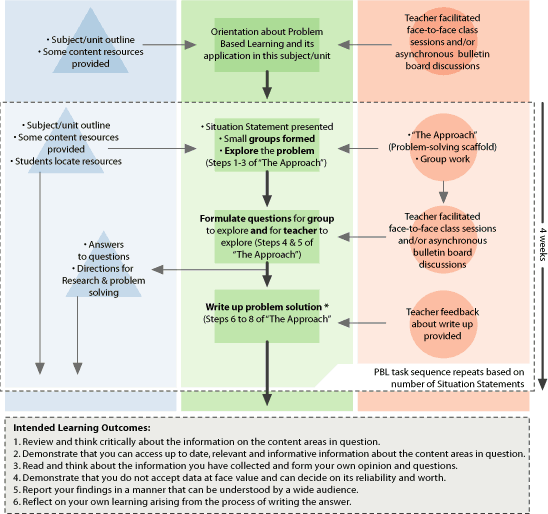|
SUPPORTS SUPPLIED
The types of supports provided are:
The learning guide - "The Approach"
"The Approach" is a significant scaffold/support
provided to the students. It involves the following steps:
1. Meet the situation (scenario).
2. Define the situation.
3. Gather the Facts:
- identify relevant experience and knowledge;
- identify what you need to know (further information and
learning);
- identify potential information/learning resources (place
ideas in 5).
4. Generate relevant questions from the previous section:
- for you to go away and answer before next class;
- for me to go away and answer in next class.
(Steps 1 to 4 will be covered in class for the "Internal"
students. For the "External" students points 3 and
4 are covered online via the Bulletin Board.)
5. Research Required (Type of…).
6. Rephrase the situation (refine the original question statement).
7. Generate answers (select possible, probable and preferable
explanations).
8. Advocate answers (choose the "best" answer and
justify it).
( Steps 6, 7 and 8 need to be written and presented in an
individual student 6 page write-up.)
Class discussion
Internal students are supported by attending and participating
in face-to-face classes where relevant material is discussed.
For example, small groups discuss the situation statement,
and are asked to discuss: What they know?, What they need
to know?What are they going to do? In order to answer these
questions the students formulate questions for the teacher
to answer, and questions for them to answer (self-directed
learning). The same process is repeated for the external students
by Asynchronous Bulletin Board Discussions.
Online discussion allows the students to raise questions
for which they realise more information will enhance their
understanding of the situation and how it is developing. Also
by reading other people’s questions they can come to
a shared idea about the situation and it tends to affirm what
they believe is going on. So usually it builds their confidence
that they are on the right track to solving the problem.
Teacher facilitation
The role of the instructor is very important, and supports
the students' learning in several ways:
The week after the introduction to the situation the students
in class are provided with answers to some of their questions
as well as direction for further research by the teacher.
The same information is provided to the external students
via the Bulletin Board or as hard copy with teaching material.
The teacher also provides instruction on how to problem-solve,
and to add meaning to the information supplied. The teacher
emphasises that having more information does not answer the
question and the students need to understand what the additional
information means and how it affects the situation.
The instructor provides feedback on student performance.
This is completed in a timely fashion, and posted on the Bulletin
Board within 2 weeks of the assignment submission. The students
also receive individual guidance on the marking sheet. Feedback:
After the three activities are assessed, feedback on student
performance is lodged on the Bulletin Board as well as provided
to students in class. Individual feedback on performance in
the various stages is also placed on the marking sheet. Students
are expected to conduct their own self-directed learning and
search for information or resources that will assist them
in problem-solving and adding meaning to the information supplied.
The level and direction of self-directed research very much
depends on the individual learning needs of the student, but
is expected to occur every week as the problem unfolds.
Internal students meet the problem (Week 2, 6 and 10 of
the semester) in class and discuss in small groups of around
6 Steps 1 to 4 of The Approach . A week later in class the
teacher provides a reply, which answers and summarises the
student questions.
External students follow the same procedure, except that
they discuss as individuals the questions they would like
to ask of the teacher on the Bulletin Board in the week following
the introduction to the problem. The teacher then responds
a week later and on the Bulletin Board provides a reply, which
answers and summarises the student questions.
The internal students also had in Week Two a "dry run"
with a scenario before going through the process in class
that exemplified the thinking and questioning skills required.
This was also done to relieve their anxiety of a learning
activity they were not familiar with.
The external students had some explanation of Problem-Based
Learning (PBL)in the handbook (hard copy and online), but
it was necessary at the residential school (some 8 weeks into
the semester) to have a follow-up session of what PBL is and
how it operates, as there were some critical misconceptions
and misunderstandings amongst the students. The third stage
of the PBL was introduced and questions raised at the residential
school. The teacher also supplied the reply at the residential
school. All situation statements and replies were available
as hard copy as well as online.
SIGNIFICANCE OF SUPPORT STRATEGIES
The significance of the support strategies is that without
them the students would have no scaffolding to support their
learning, and for those (the majority) who have never been
confronted with PBL then this aspect is very important. The
support framework enables students to build confidence about
their problem solving ability especially for those students
who are less familiar with the content material and its meaning.
SUPPORT STRATEGY ADAPTATION
At this stage all forms of support are critical, unless the
students had greater computer/internet access in which case
some of the hard copy material could be optional. Most of
the students rely a lot on visual learning, and thus the face-to-face
component with the teacher was very valuable to them.
|
